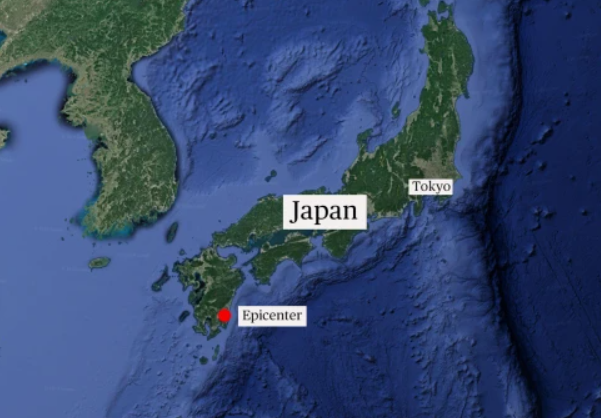Southwestern Japan on High Alert After 7.1 Magnitude Earthquake Triggers Tsunami Warning
A Powerful Earthquake Shakes Miyazaki – In the early hours of Thursday, a powerful earthquake with a magnitude of 7.1 struck near the coastal region of Miyazaki Prefecture, Japan. According to the Japan Meteorological Agency (JMA), the earthquake’s intensity was recorded as a lower 6 on Japan’s seismic intensity scale, which ranges from 0 to 7. This scale measures the degree of shaking experienced at various locations, and a lower 6 indicates significant ground motion capable of causing structural damage and posing serious risks to life and property.
The epicenter of this earthquake was located offshore, which led to immediate concerns about the possibility of a tsunami. The tremors were felt across Miyazaki and several surrounding prefectures, leading to widespread anxiety and precautionary measures. This earthquake is one of the most powerful to hit the region in recent years, prompting swift action from local and national authorities.
Tsunami Warning Issued for Coastal Regions
In the wake of the earthquake, the Japan Meteorological Agency quickly issued a tsunami warning for the coastal areas of Miyazaki and four other prefectures: Kochi, Oita, Kagoshima, and Ehime. These regions are now on high alert as the agency has warned of the possibility of tsunami waves reaching up to one meter in height.
The JMA’s warning is based on the potential for undersea seismic activity to displace large amounts of water, which can generate tsunami waves. Even a tsunami wave of one meter can cause significant flooding, especially in low-lying coastal areas. The warning covers a broad swath of southwestern Japan, an area known for its beautiful coastlines and thriving fishing communities, making the potential impact of a tsunami particularly concerning.
Residents and authorities in the affected areas have been urged to take immediate precautions. The JMA has strongly advised people to avoid rivers, river mouths, and coastal areas. In many towns and cities, local governments have activated their emergency response plans, which include opening evacuation centers and deploying emergency services to assist those in need.
Authorities Take Swift Action
In response to the tsunami warning, local governments in the affected prefectures have issued evacuation advisories, urging residents in coastal areas to move to higher ground. Schools, businesses, and public facilities near the coast have been closed as a precaution. Authorities are closely monitoring the situation, and updates are being provided through various channels, including television, radio, and social media, to keep the public informed.
The Japan Self-Defense Forces (JSDF) have also been placed on standby, ready to assist with evacuation efforts and provide emergency relief if necessary. In addition, the Coast Guard has been dispatched to patrol the coastal waters, ensuring that boats and ships are moved to safer locations away from potential tsunami zones.
The response from authorities has been swift, reflecting Japan’s well-prepared disaster management system, which is among the most advanced in the world. However, the situation remains tense as residents await further updates on the possibility of a tsunami and any aftershocks that may follow the initial earthquake.
Public Urged to Stay Vigilant
As the situation unfolds, the Japan Meteorological Agency continues to monitor seismic activity in the region. While the immediate focus is on the potential tsunami, there is also concern about the possibility of aftershocks, which are common after significant earthquakes and can sometimes be nearly as powerful as the initial quake.
The JMA has urged the public to remain vigilant and to follow the guidance of local authorities. People living in the affected areas are being reminded to prepare emergency kits, stay informed through official channels, and be ready to evacuate at a moment’s notice if necessary. The agency has emphasized that while the initial tsunami warning is for waves up to one meter, the situation can evolve, and it is essential to stay alert.
Japan’s Preparedness in the Face of Natural Disasters
Japan is no stranger to earthquakes and tsunamis, given its location along the Pacific Ring of Fire, where several tectonic plates converge. The country has a long history of natural disasters, and as a result, it has developed a robust disaster preparedness and response system. This includes early warning systems, public education campaigns, and regular disaster drills.










